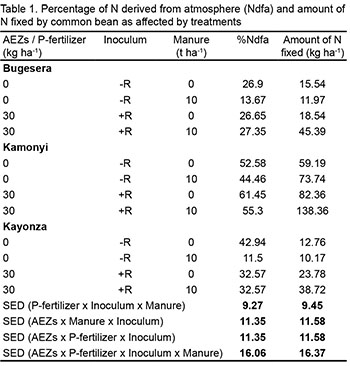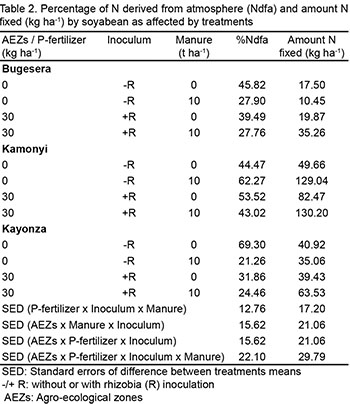One of my major research activities was a set of trials that evaluated the role of inoculation, P-fertilizer and manure application on common bean and soyabean yield and yield components. As part of this work, I measured nitrogen fixation in both legumes using the 15N-natural abundance method. The proportion of nitrogen derived from atmosphere (%Ndfa) differed between the two legumes (Table 1 and 2).
 |
 |
For both bean and soyabean, the %Ndfa and amount of N2 fixed were in most cases greater with inoculation, irrespective of manure addition. Application of manure alone led to less %Ndfa, but with a larger amount of N2 fixed in both legumes. This high amount of N2 fixed in manured and inoculated treatments is due to good performance of the two legumes resulting in high biomass and good nodulation (Picture 1) recorded at mid-podding compared to control plot (Picture 2). The amount of N2 fixed also differed between the two legumes and was on average greater in soyabean than in common bean, though the largest value recorded was in common bean (138.36 kg N ha-1). Soyabean produced high biomass in two of the three agro-ecological zones (AEZs), which explained the high amount of N2 fixed. The amounts of N2 fixed were also affected by environmental conditions, with highest amount of N2 fixed observed in AEZ with higher rainfall (Kamonyi).
 |
Left: Picture 1. Soyabean inoculated, with P-fertilizer and manure in Bugesera Right: Picture 2. Soyabean without inoculation, P-fertilizer and manure in Bugesera |
 |
This study showed that better management leads to substantial amounts of N2 fixed across the three agro-ecological zones, for both common bean and soyabean. Targeting of legumes to different environmental conditions should consider management as a key driver.
Edouard Rurangwa, Wageningen University, The Netherlands (Click here for his 2015 update)
